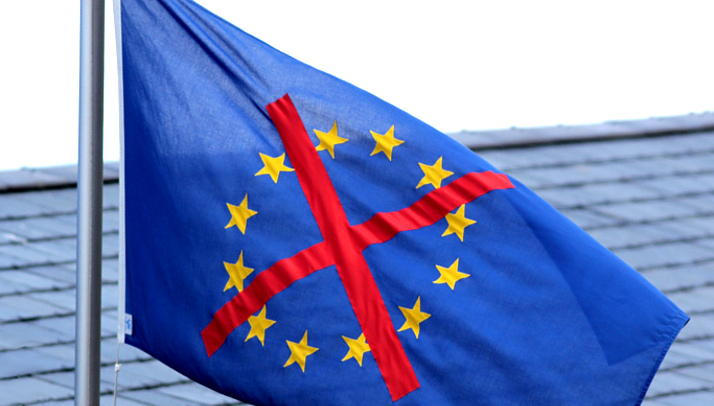British officials have told the French not to display the European Union flag or other symbols of the EU during ceremonies marking the 1914-18 war, and warned them not to use the centenary of the Great War to promote the EU.
According to a report in the Daily Telegraph senior British sources have told the French the commemoration services “should not be about politics.”
The warning follows “British unease” after the French displayed the EU flag earlier this month during ceremonies to mark the 70th anniversary of the D-Day landings on the Normandy coast, even though the EU did not exist during either world war and is not the symbol of any of the countries whose people fought and died in the wars.
On senior government official was quoted: “The way the French brought out the EU flag during the D-Day ceremony was like Alex Salmond waving the Scottish flag at Wimbledon.”
“We have said we don’t want any narrative in the commemorations which suggests that the European Union has prevented another conflagration.”
However, British officials and politicians may have to endure a sea of EU flags at a war commemoration later this week.
Herman Van Rompuy, the president of the European Council, has arranged for this week’s two-day meeting of the council to start at Ypres, the Belgian Flemish city whose surrounding flatlands saw some of the bloodiest and most sustained battles of the First World War.
David Cameron and the other heads of state and government will inevitably find themselves pictured in front of EU flags as they arrive for a ceremony organised by Van Rompuy at the Menin Gate, a memorial on the main road along which the soldiers marched to battle.
The council says that to mark the occasion, the EU “is donating a symbolic bench, for people to come to sit on and remember the dead.”
The so-called “peace bench,” with the word peace written in the 24 languages of the EU member states, will be dedicated by Cameron and other EU leaders after the Last Post is sounded at the Menin Gate.
In a line which should enrage those British officials who say they have warned the French not to use war commemorations for EU politics, Van Rompuy has described this week’s ceremony in pure Brussels propaganda terms, linking the EU to the peace in Europe which has followed the two world wars.
Van Rompuy said: “It will be a moving ceremony as we will be testifying to what Europe is: a project of peace, solidarity and cooperation. We are not perfect, but for many people outside Europe we are still a model: a model of peace, democracy, prosperity and social protection.”
Display of the blue and gold-starred EU flag is a gesture encouraged and in some cases demanded by EU regulations. Any project in receipt of EU funds is required to display the blue and gold-starred symbol, either as a flag, a plaque or a symbol.
During the week of May 9th, the EU’s “Europe Day,” the symbol must be shown “in a place visible to the public” in government buildings which manage structural funds “as a symbol of partnership.” The British Labour government agreed to this requirement in 2007, though Conservative Cabinet minister have been placing the flag in the basements of their buildings as an act of defiance.
The European Commission has a relentless series of taxpayer-funded propaganda events meant to make so-called EU citizens embrace “their” flag. This summer the commission is again running a “Europe in my region photographic competition.”
Contestants must download pictures “depicting an EU-funded project provided the EU flag and funding information is visible somewhere in the picture.” Winners receive €1,000 (£800) worth of camera equipment and a trip to Brussels.

COMMENTS
Please let us know if you're having issues with commenting.